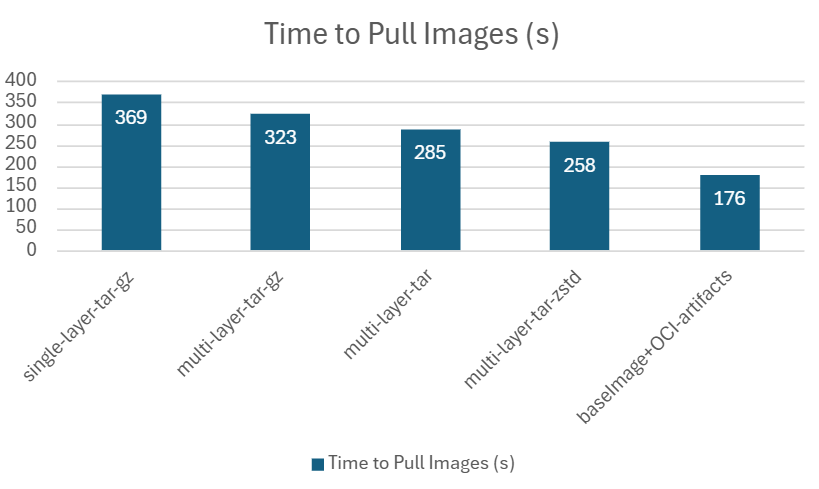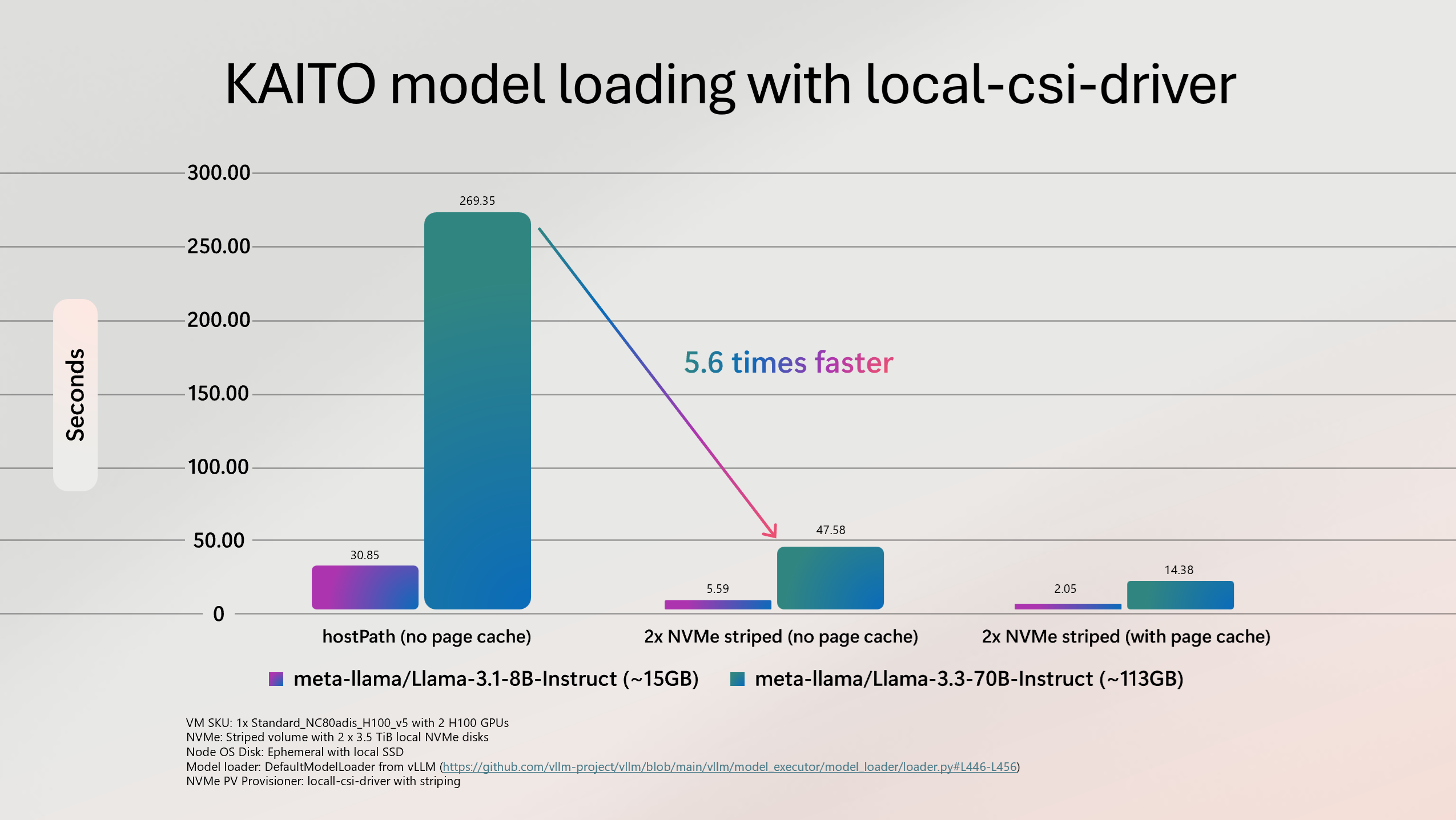Model As OCI Artifacts
KAITO efficiently distributes Large Language Models (LLMs) by leveraging Open Container Initiative (OCI) Artifacts to package and deploy model weights separately from the inference runtime. This architecture provides superior performance, scalability, and maintainability for large language model deployments.
Overview
KAITO uses a split architecture approach for model distribution:
- Base Images: Contain the inference runtime and dependencies
- OCI Artifacts: Contain the model weights and configuration files stored separately in OCI registries
This design choice enables KAITO to optimize both build and deployment performance while maintaining compatibility with standard container infrastructure. The model weights are downloaded as OCI artifacts during pod initialization, providing faster deployment times and more efficient resource utilization compared to traditional monolithic container images.
Design Rationale
KAITO chose the OCI Artifacts approach to address fundamental challenges in large language model distribution and deployment:
Build Efficiency
By separating model weights from base images, KAITO eliminates redundant rebuilds:
- Reduced Build Time: Model images only need to be built once and can be reused across base image updates
- Efficient Build Context: Large model files are not included in Docker build context, avoiding unnecessary transfers
- Resource Optimization: Build processes for large models like Falcon-40B are reduced from nearly 2 hours to minutes
Deployment Performance
KAITO's OCI Artifacts approach optimizes the deployment pipeline:
- Concurrent Downloads: Model weights can be downloaded in parallel, improving bandwidth utilization
- Advanced Compression: Zstd compression provides better decompression performance than traditional gzip
- Optimized Unpacking: Separate artifact handling reduces serialization bottlenecks during pod startup
Understanding Container Performance
KAITO's design optimizes all phases of the container pull process:
- Downloading layer data from the registry
- Decompressing the layer if necessary
- Checking sha256 digest
- Unpacking the layer, applying changes to the snapshot
KAITO addresses these performance characteristics by optimizing not just the download phase (30% of total time) but also the decompression, validation, and unpacking phases through its OCI Artifacts approach.
How KAITO Uses OCI Artifacts
1. Efficient Build Process
KAITO uses ORAS to package model weights and configuration files directly into OCI artifacts without requiring large build contexts. This approach achieves the same distribution goals as traditional Docker builds but with significantly improved efficiency.
2. Optimized Compression
KAITO employs zstd compression instead of gzip, providing superior decompression performance specifically optimized for large model weight files.
3. Split Architecture Design
KAITO implements a two-component architecture:
- Base Image: Contains the inference runtime and dependencies
- OCI Artifacts: Contains the model weights and configuration files
This architectural separation enables model images to be built once and reused across multiple base image updates, significantly reducing maintenance overhead.
4. Caching OCI Artifacts on High-Performance Local Storage
For optimal model loading speed, KAITO caches model weights on high-performance local storage, such as NVMe disks available on GPU VMs. When local NVMe disks are present, KAITO provisions persistent volumes using the local-csi-driver. This setup ensures that model weights are stored and accessed from fast, local storage, significantly reducing model load times and improving inference startup performance.
When to Use OCI Artifacts
KAITO automatically uses OCI Artifacts for supported models, providing benefits in several scenarios:
Recommended Use Cases
- Large Language Models: Models with weights exceeding 1GB benefit significantly from the optimized distribution
- Frequent Updates: Environments with regular base image updates for security patches or feature additions
- Multi-Model Deployments: When deploying multiple model variants that share similar runtime requirements
- Resource-Constrained Environments: Clusters where build time and bandwidth optimization are critical
Performance Considerations
The OCI Artifacts approach provides the most benefit when:
- Model weights are large relative to the runtime container
- Network bandwidth is limited or expensive
- Build infrastructure resources are constrained
- Deployment frequency is high
- High-performance local storage is available for caching
Architecture
Model Weights Download Process
The system uses an initContainer to download model weights as OCI artifacts using ORAS:
OCI Artifacts vs OCI Images
The Open Container Initiative (OCI) defines specifications and standards for container technologies, including the OCI Distribution Specification. OCI Image Manifests have a required field config.mediaType that differentiates between various types of artifacts.
- OCI Image: A subset of OCI artifacts, accepting only specific mediatypes
- OCI Artifacts: More general format that can contain various types of content including model weights
ORAS (OCI Registry As Storage) is the tool used for managing OCI artifacts, including pushing, pulling, and handling metadata in OCI registries.
Alternative Approaches for Large Models
For extremely large models that may not be practical to package as OCI artifacts due to size constraints, KAITO also supports:
- Direct Download from Hugging Face: Models can be downloaded directly from Hugging Face Hub during pod initialization for models that exceed registry limitations
- External Model Caching: Integration with external model caching solutions for improved performance with very large models
Compatibility
Container Runtimes
- CRI-O: Supports general OCI artifacts
- Containerd: Limited support for OCI artifacts (see containerd issue)
OCI Registries
Most OCI registries support OCI artifacts. For a complete list of compatible registries, see the ORAS compatibility documentation.
Benefits
Performance Improvements
- Reduced Build Time: Model images only need to be built once
- Faster Pulls: Improved download concurrency and compression
- Better Resource Usage: Optimized bandwidth utilization
- Faster model loading: Reduced model load times and improved inference startup latency, when high-performance local storage is available.
Operational Benefits
- Simplified Maintenance: Base image updates don't require rebuilding all model images
- Storage Efficiency: Better compression ratios with zstd
- Scalability: More efficient handling of large model files
Performance Results
Testing on Standard_NC24s_v3 with phi4 model shows significant improvements:

The evaluation compared different configurations:
| Configuration | Description | Benefits |
|---|---|---|
| Baseline (single-layer-tar-gz) | Current approach with all files in one layer | Simple, self-contained |
| OCI Artifacts | Base image + separate model artifacts | Reduced build time, better performance |
When caching model files on local NVMe disks, testing on Standard_NC80adis_H100_v5 with Llama-3.3-70B-Instruct model shows significant improvements on model loading times:

Getting Started
Automatic Usage
KAITO automatically uses OCI Artifacts for supported models when the feature is available. No additional configuration is required - simply deploy your model using standard KAITO workflows and the system will optimize the distribution automatically.
Verifying OCI Artifacts Usage
To confirm that your model is using OCI Artifacts:
- Check the pod specification for initContainers that download model artifacts
- Monitor pod startup times for improved performance compared to traditional container pulls
- Review registry storage to see separate base images and model artifact entries
Troubleshooting
If you encounter issues with OCI Artifacts:
- Ensure your container runtime supports OCI Artifacts (see Compatibility section)
- Verify registry compatibility with OCI Artifacts specification
- Check initContainer logs for artifact download status
- Refer to the technical specification for advanced configuration options